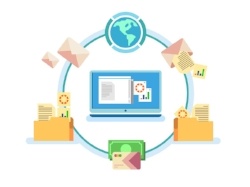The Enhanced Security of Electronic Document Flow
 There is no question that electronic documents have improved credit union efficiency, making every aspect of document management better. This includes increasing convenience for members, improving document retention strategies and providing enhanced security. With the correct strategies, electronic documents also enable credit union employees to have the most up-to-date information at all times on every member account. However, with the reality of increasing cybersecurity threats, there is a misconception: going paperless is somehow less secure than paper itself. Consider these 6 ways a paperless system is more secure:
There is no question that electronic documents have improved credit union efficiency, making every aspect of document management better. This includes increasing convenience for members, improving document retention strategies and providing enhanced security. With the correct strategies, electronic documents also enable credit union employees to have the most up-to-date information at all times on every member account. However, with the reality of increasing cybersecurity threats, there is a misconception: going paperless is somehow less secure than paper itself. Consider these 6 ways a paperless system is more secure:
1. Document Loss - With paper files being moved around, it is very easy to lose all or part of valuable documents. Whether it's due to lost pages when making copies, misplaced documents when filing, or a member that lost pages somewhere between the credit union branch and home, document loss happens more than we'd like to admit. Going paperless eliminates that possibility.
2. Physical Space - Relying on paper documents means you need to have space to store them. Filing cabinets are heavy, expensive and take up precious space. With data storage costs (both on devices and in the cloud) becoming less expensive, space is not an issue in a paperless environment. Why is space a security concern? As your document filing needs get bigger, it is tempting to move older documents with member sensitive data out of secure, fireproof cabinets to boxes that get stored in locations that are far less secure.
3. Unauthorized Access - Speaking of filing cabinets, they should have a lock and key. Who has access to those keys? Is the key kept nearby where everyone can see it, or perhaps you tend to leave those file folders open during business hours, where everyone in your credit union can gain access. With electronic documents, you have the ability to control access to only the people who have permissions for those files, including the members themselves. When was the last time your members accessed copies of their loan documents or signature cards through your online services? With the correct paperless system not only can your staff access member documents, but your members can too.
4. Tampering - This is a no-brainer - with electronic document flow, you can control who can make changes, view every change made to the document, and can see who made those changes. Tampering with electronic documents is practically impossible without someone knowing about it. The same cannot be said for paper.
5. Encryption - Sending documents requiring eSignatures to members or third parties using encrypted channels, is not only a time saver, it is also more secure than using standard mail service, where items change hands so many times and people you don't know can open and tamper with documentation without approval. Electronic data can be encrypted so that even if the files are copied or stolen, the information can be protected. There's no encryption for paper, unless you're James Bond and have invisible ink...
6. Disaster Recovery - Backup and recovery of electronic documents is much cheaper and more reliable than paper backups, and easier to restore. Recovering lost data can happen in a moment with proper backups in place, which is easy with private cloud storage. Paper documents that are exposed to disastrous circumstances, like fire or flood, can be lost forever.



